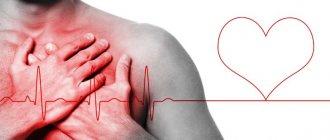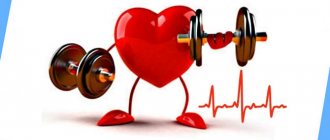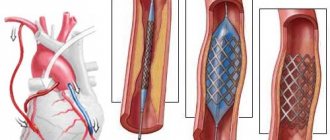Indications
A stress ECG is carried out to study people involved in professional sports; it is necessary for the flight personnel of military and civil aviation, people working in rescue services, and special forces. Electrocardiography is also prescribed for children who need to clarify the opportunity to engage in any kind of sport, to clarify the cause of rapid heartbeats, pain in the chest area.
In addition, it is recommended to do the procedure if you have:
- ischemic disease;
- previous myocardial infarction, coronary artery bypass surgery;
- heart disease;
- sinus arrhythmia;
- coronary artery stenosis;
- impaired atrioventricular conduction.
The indicators obtained during the procedure are used either to confirm the diagnosis or to exclude it. The study also makes it possible to monitor the effectiveness of prescribed therapy for cardiovascular pathologies before the rehabilitation period after a myocardial infarction or cardiac surgery.
ECG using bicycle ergometry
An ECG using the bicycle ergometry method is considered the best way to diagnose a patient’s heart during an attack. With its help, you can easily detect most dangerous heart pathologies, including angina, even in the early stages of development.
The procedure is carried out using a special device (completely identical to an exercise bike) connected to a computer and several sensors that are attached to the patient’s chest and read heart function and blood pressure. At the beginning of the procedure, the patient must pedal the exercise bike at a speed of 60 revolutions per minute. After every 180 seconds, the pace gradually increases, and so on until the first pain in the chest area or other symptoms of cardiac pathologies (nausea, fatigue, dizziness, etc.) appear.
Bicycle ergometry method
During the procedure, the cardiogram displays health indicators, based on which the doctor can draw conclusions. ECG readings are also taken after exercise for 10–25 minutes in order to notice the difference in the work of the heart and myocardium at rest and activity.
Methods of conducting research
Based on the diagnostic method, a cardiogram with exercise is performed using the following methods: functional tests, bicycle ergometry, treadmill, and Holter monitoring. Patients suffering from heart disease are prescribed an ECG under stress using a functional test technique, since these indicators are among the most accurate.
Functional tests
During electrocardiographic examination using functional tests, there is no need for additional equipment. The doctor needs an electrocardiograph with a stopwatch. This greatly simplifies the diagnostic technique. Its essence is to take cardiac readings from the subject before and after physical activity, which helps to detect failures that may indicate the presence of a hidden heart disease.
In the form of exercises to study the work of the myocardium, the following is used:
- running test. During the diagnosis, the subject runs in place at his personal maximum pace for 15 seconds. If, as a result of advanced age or the patient’s condition, it is not possible to actively perform this exercise, then the running pace is allowed to slow down, and the time required to complete the task should increase;
- Martinet's method. Its implementation is similar to the running test technique. This method involves doing 20 squats instead of running. Squats must be completed in 30 seconds. During this procedure, three readings of the functioning of the heart muscle are taken. Before starting the exercise, after finishing it, 3 minutes after the proposed load;
- The step test is carried out less often than the first two types of diagnostics. Since it requires equipment in the form of a step platform or a staircase equipped with 4 steps. This method consists of 20 exercises, which are no different in effectiveness from the Martinet technique or the running test;
- clino-orthostatic tests are most often used to study children who have signs of cardiac pathology. Before performing these tests, the child is connected to electrocardiographic equipment, which will continuously read information about the functioning of the myocardium during the procedure. At the beginning of the study, the doctor measures blood pressure and records the results obtained. Then the child needs to lie down on the couch and lie still for 10 minutes, during which the current data is recorded. Next, the little patient is asked to stand for 10 minutes. An electrocardiogram will also be taken at this time. At the end of the procedure, he needs to lie down again and lie down for 5 minutes. After this, he is disconnected from the electrocardiograph. The normal blood pressure before and after the clino-orthostatic test should be within the permissible excess, 5–20 mm. Heart rate should not increase by 20-40%. Increased parameters are an indicator of the presence of cardiac pathologies.
During the Martinet technique, a treadmill is used
Bicycle ergometry
Bicycle ergometry is the best method for diagnosing the heart muscle during an attack. It allows you to timely identify many dangerous cardiac pathologies, including angina pectoris at an early stage of its development. The procedure is carried out using a special apparatus, which is identical to an exercise bike. On the one hand, it is connected to a computer, and on the other, several sensors are connected to the patient’s chest.
At the same time, readings of the work of the heart muscle and blood pressure are taken. At the very beginning of the procedure, the subject pedals at a speed of no more than 60 revolutions per minute. After 3 minutes, the pace gradually increases until the first appearance of pain in the chest or other indicators of cardiac malaise: nausea, dizziness, fatigue.
During diagnosis, the electrocardiograph displays health indicators. Based on them, the specialist draws conclusions. Next, an ECG is taken 15 minutes after exercise. This makes it possible to record the difference in myocardial functioning during periods of activity and rest.
Treadmill technique
The Treadmill method is a kind of prototype of bicycle ergometry. The only difference is that this method is carried out not on an exercise bike, but on a treadmill. In this case, the track will be responsible for setting the pace and simulating the rise. This technique is used not only for diagnosing adults, but also for children, in contrast to bicycle ergometry.
The results are read and deciphered by a computer that continuously measures such important parameters as blood pressure and heart rate.
Holter monitoring
The essence of Holter monitoring is to attach a sensor to the subject that reads the heart rate not only during activity, but also during sleep. Usually the holter is attached for a day and records all changes during a given period of time. At the same time, this patient maintains a protocol in which all loads and medication intake are recorded. Next, the information is read by a specialist. Usually the conclusion is issued the next day.
How is an ECG of the heart performed?
The essence of an electrocardiographic study is to register electrical potentials arising during cardiac work and their graphical display on paper (or a monitor).
The procedure lasts on average 5-10 minutes. The patient is asked to undress to the waist, expose the wrists and ankles, and lie down on the couch.
For the study, metal electrodes are used, which are lubricated with a special gel at the points of attachment to the body (it helps improve current conductivity).
Electrodes are placed on the wrists, ankles, and areas of the front and side of the chest. Through these sensors, the ECG machine - electrocardiograph - receives information about the work of the heart.
The electrical potentials sensed by the device through the electrodes on the patient's body are amplified several hundred times during transmission, activating the galvanometer. The fluctuations of the latter are recorded on paper in the form of a graph - an electrocardiogram.
ECG with interpretation
Upon completion of the study, the cardiologist begins to decipher the electrocardiogram.
First of all, when studying an ECG, a specialist looks at the heart rate indicators, comparing the intervals between the R waves: they should be the same, if not, the rhythm is incorrect.
Next, the heart rate (HR) is calculated: normally, this indicator should not go beyond 60-90 beats per minute.
The P wave determines the source of excitation in the heart. For a healthy organ, sinus rhythm is the norm, while atrial, ventricular and atrioventricular rhythms indicate pathology.
Changes in cardiac conduction are assessed by the duration of waves and segments: each of them has its own normal limits.
The amplitude of the waves is one of the most important indicators of the ECG. An increase in this parameter indicates hypertrophy of some parts of the heart. And this tells the doctor about the existing pathology, for example, hypertension.
In an ECG with interpretation, the electrical axis of the heart (EOS) is necessarily determined. For people with an asthenic type of build, a more vertical position of the EOS is typical, for patients with a hypersthenic build - a more horizontal position. With serious changes in the heart, the axis shifts sharply to the right or left.
Having studied these and other indicators of the electrocardiogram in detail, the doctor gives a conclusion in which he evaluates the correctness of the rhythm, the source of excitation, heart rate, characterizes the EOS, and also points to specific pathological processes, if any.
Only an experienced specialist who thoroughly understands the relationships between all elements of the cardiac curve should interpret the ECG results!
Contraindications
It is prohibited to perform an electrocardiographic examination with stress in the presence of the following serious pathologies:
Carrying out a treadmill test
- acute myocardial infarction;
- endocarditis, myocarditis;
- cerebrovascular accidents;
- severe heart defects;
- heart failure grade 3, 4;
- for arrhythmias;
- blockades;
- arterial hypertension;
- thrombosis, thromboembolism.
It is also prohibited to undergo examination in the presence of pathologies that are not classified as cardiac, but interfere with the performance of physical activity of the body. Loading the right atrium on the ECG is contraindicated after bronchitis or pneumonia. Before diagnosis, you should not smoke, as nicotine can cause an unreliable result.
Calculate your maximum heart rate
We have determined our condition, let's move on. Let's calculate your maximum heart rate during exercise.
There are special tables to determine the maximum heart rate. Athletes need them more. A simplified formula will suit us: 220 - age (i.e., if you are 50 years old, then your maximum allowable heart rate is 220 - 50 = 170).
The maximum heart rate is the limit over which an untrained person should not cross. The greatest health effect is obtained during exercise, when the heart rate reaches 75-85% of the maximum. Moreover, 85% refer to practically healthy people, and 75% refer to those with health problems. For patients with coronary artery disease, it is generally better to start with 50% of the maximum. For our example, 75% corresponds to 127 beats (170*0.75=127.5), and 85% corresponds to 144.
Decoding
The data obtained is deciphered by a cardiologist who pays attention to the following teeth:
- T, which is responsible for the repolarization of the right and left ventricles;
- smeared U waves are an indicator of repolarization of the distal portion of the conduction system;
- P speaks of atrial depolarization;
- The QRS complex is an indicator of ventricular depolarization.
Upward directed teeth are positive, downward directed teeth are negative. Moreover, the R wave will always be positive, S, Q - negative.
Stress ECG: what results indicate normality?
To identify various cardiac pathologies, an electrocardiogram is often prescribed. The method is actually very simple. However, it is considered one of the most informative. If the procedure does not show clear results, the patient is prescribed a stress ECG. The technique allows you to identify hidden pathologies and prescribe adequate treatment.
General description of the procedure
Almost every person has had to undergo a procedure called electrocardiography (ECG) at least once.
It is a registration of electrical impulses (currents) during contraction of the heart muscle. A special device, an electrocardiograph, allows you to record data and display it on a graph.
The resulting result looks like a complex curved line. The doctor usually deciphers the obtained values.
A fairly simple method for diagnosing heart disease allows you to get accurate results. An electrocardiogram is one of the cheapest and most accessible methods. Another advantage is the absence of violations of the integrity of the skin.
Electrocardiography with exercise
There are several methods for performing electrocardiography, one of which is stress ECG. The usual procedure, when the patient is at rest, does not always show all the abnormalities in the heart. Registration of cardiac impulses during physical activity allows us to establish the exact cause of the pathology due to the active work of the heart muscle and the entire body as a whole.
There are several ways to perform stress electrocardiography. One of the common methods is functional tests. No special devices are used, other than a stopwatch and a cardiograph. The patient is asked to perform simple exercises. This could be squats or steps on a step platform.
Bicycle ergometry is considered one of the most informative methods for diagnosing the performance of the heart muscle. To carry it out, an exercise bike is used, equipped with special sensors and a powerful computer. When performing an ECG with physical activity, all data will be transferred to a computer for recording and analysis.
The treadmill test has a similar diagnostic technique, only a treadmill is used for physical activity. If the patient begins to feel unwell, the diagnosis will be completed and the necessary medical care will be provided.
Indications for use
The procedure allows you to promptly detect existing problems with the heart muscle and establish the level of endurance in each patient. An electrocardiogram is one of the mandatory diagnostic methods for people who work in difficult conditions.
The procedure may be prescribed if a standard ECG does not show any abnormalities, but the patient complains of the periodic appearance of unpleasant symptoms. Direct indications for undergoing manipulation with a gradually increasing load are the following pathologies:
- the need to determine the type and degree of coronary heart disease;
- atrial fibrillation;
- complaints of frequent pain in the heart area;
- hypertension;
- congenital and acquired heart pathologies;
- arrhythmia, tachycardia;
- the appearance of bluish skin or sudden weakness.
If preliminary diagnostics using an electrocardiograph indicates the presence of heart pathology, then performing a stress test does not make sense.
Contraindications
Before prescribing a stress ECG to a patient, the specialist must ensure that there are no contraindications. Because in some cases this type of diagnosis can be life-threatening. In medical practice, there are absolute and relative contraindications to manipulation. The first group includes severe pathologies:
- condition after a myocardial infarction (the procedure can be performed no earlier than 14 days after the attack);
- arrhythmia that is not amenable to medication;
- severe infectious pathologies;
- pericarditis, myocarditis, endocarditis;
- acute heart failure;
- pulmonary embolism;
- aortic stenosis in severe form;
- suspicion of dissection of an aneurysm in a vessel.
If the patient has relative contraindications, only the physician should determine the need for electrocardiography with exercise.
Diagnostics is usually prescribed only as a last resort, when other methods have proven ineffective. This category includes pathological conditions such as a lack of magnesium and calcium, severe diabetes mellitus, heart defects with moderate stenosis, ventricular extrasystole, hypothyroidism, left ventricular aneurysm, and late pregnancy.
How is the procedure done?
To do a stress ECG, you need to contact a cardiologist and undergo a preliminary examination. If the patient has no contraindications, he may be prescribed a test on an exercise bike (bicycle ergometry) or treadmill. The most informative and frequently used is the first option.
Before starting the diagnosis, the specialist attaches sensors to the patient’s skin. The procedure will be carried out with simultaneous recording of blood pressure. Sensors are attached to the collarbone, shoulder blades and lower back.
In the first three minutes, you need to make 180 revolutions of the simulator (60 revolutions every minute). Every three minutes the load will be increased until fatigue, dizziness or pain appear.
The patient must report his feelings and the doctor will complete the ECG procedure. After the load, data is recorded for another 10 minutes. This time is usually enough for the heart rate to return to normal. The results are sent to the doctor to make a diagnosis.
We correctly decipher the results
An ECG with stress allows you to obtain the most reliable information about the condition of the heart muscle and blood vessels. The conclusion contains the following indicators:
- Work performed by the patient (J).
- Threshold power (W).
- Reasons for early termination of the study.
- Conclusion about performance.
- Dynamics of pulse and blood pressure.
- The time it took for heart rate and blood pressure to normalize.
- The value of blood pressure at the peak of physical activity.
- Heart rhythm disturbances (normally there should not be one).
- Coronary disorders (detailed description of the type of disorder, time of its occurrence).
- IHD class depending on the level of physical activity at which the deviations appeared.
Only a specialist is responsible for interpreting the results of a stress ECG. The norm of indicators differs depending on the age and gender of the patient. The slightest deviations from generally accepted norms do not indicate the presence of a pathological condition. If necessary, the procedure can be repeated after some time.
A negative option indicates high performance and the absence of changes in the ECG with exercise.
A test is considered questionable if a shift in the ST segment is detected (a change in the interval on the graph between the S and T waves).
The reason for this phenomenon may lie in increased pulmonary ventilation, frequent stress, long-term therapy with antiarrhythmic medications, and potassium deficiency in the body.
If the test is positive, the patient experiences atrial fibrillation, frequent extrasystoles, and ST segment displacement of more than 2 mm. In this case, it is important to note the period when such signs appeared, the maximum load, and heart rate.
What does the load on the right atrium indicate?
The ECG records various pathologies of the heart muscle. One of the dangerous syndromes is hypertrophy of the right atrium. This pathology is often observed in diseases of the respiratory organs, because this part of the heart interacts specifically with the pulmonary system. With congenital defects of the pulmonary artery, overload of the right atrium also occurs.
Valve pathologies can be noticed during an electrocardiogram. A sign of deviation is a change in the P wave. A timely diagnosis will allow the initiation of therapy aimed at eliminating this phenomenon.
Preparation for the procedure
To get a reliable result, you need to properly prepare for an ECG with stress. Before the test, you should avoid emotional and physical stress and stop drinking alcoholic beverages. For several days, you should avoid taking medications that affect the functioning of the heart muscle. Heavy foods can have a negative impact on the test result.
Source: https://FB.ru/article/271681/ekg-s-nagruzkoy-kakie-rezultatyi-svidetelstvuyut-o-norme
Norms and pathologies
Each person has individual physiological characteristics in which the heart shifts from its usual location. The weight of the ventricles, conduction velocity, and its intensity may also change. Based on this, a vertical and horizontal description of the results is required, allowing one to assess the individual characteristics of the patient. Decoding should be carried out in a certain sequence, which helps to differentiate the indicators of norms.
First of all, the heart rate and heart rate are assessed. The norms are represented by sinus rhythm and heart rate in an adult from 60 to 80 beats per minute. Otherwise, a diagnosis of sinus tachycardia is made. Intervals are calculated that indicate the duration of the contraction phase; its normal values vary from 390 to 450 ms. When it lengthens, a diagnosis of atherosclerosis, rheumatism, and myocarditis is made. A shortened interval means the presence of hypercalcemia.
A normal indicator would be the position of the R wave higher than the S wave. If the axis is shifted to the right, then the patient’s right ventricle is malfunctioning. Left axis deviation indicates the presence of left ventricular hypertrophy. When examining the QRS complex, normal parameters are represented by the absence of a pathological Q wave, and it should not be more than 120 ms wide. The confusion of the interval indicates the His bundle.
When describing the ST segments, attention is paid to the recovery period. Normal indicators should fall on the isoline. A full interpretation of the results should be carried out exclusively by a cardiologist. A stress ECG can detect multiple hidden diseases of the cardiovascular system.
Treadmill ECG method
This exercise ECG is a partial prototype of the bicycle ergometry method, with the difference that with a treadmill the patient will perform the exercise on a treadmill rather than on an exercise bike. However, in this case, the track will speed up the pace and simulate an upward climb by changing the angle of inclination.
Method of conducting an ECG with a treadmill load
The treadmill heart examination technique is suitable for both adult patients and children, which cannot be said about its analogue. Reading and interpretation of the ECG during this technique is performed by a computer that continuously measures all vital signs (heart rate, blood pressure, etc.)
Functional tests
This method is used to assess the work of the heart during qualification tests for certain professions - athletes, pilots, military personnel. With the help of functional tests, it is possible to determine hidden pathologies and the endurance of the heart to certain loads.
It is also permissible to use the methodology to assess the health of children before entering the sports section.
The test technique has several options:
- Martinet method - consists of 20 squats performed within 30 seconds. Readings are taken before physical activity, immediately after it and three minutes later;
- running tests - similar to the first test, only with running instead of squats;
- step test - has more than 20 types of tests, each of them has its own norms of indicators;
- clinoorthostatic – procedure for children. The necessary equipment is attached to the child, after which readings are taken in a lying and standing position. Normal indicators are an increase in heart rate within 20–40%.
Techniques
There are several ways to perform stress electrocardiography. One of the common methods is functional tests. No special devices are used, other than a stopwatch and a cardiograph. The patient is asked to perform simple exercises. This could be squats or steps on a step platform.
Bicycle ergometry is considered one of the most informative methods for diagnosing the performance of the heart muscle. To carry it out, an exercise bike is used, equipped with special sensors and a powerful computer. When performing an ECG with physical activity, all data will be transferred to a computer for recording and analysis.
The treadmill test has a similar diagnostic technique, only a treadmill is used for physical activity. If the patient begins to feel unwell, the diagnosis will be completed and the necessary medical care will be provided.
Holter monitoring method
The method is considered an ineffective way to examine the heart for the presence of serious pathologies, since it is carried out with the patient’s balanced voltage, which is not enough to trigger an attack. The essence of the method is to attach a Holter sensor to the patient for a day, which will read heart rate indicators during sleep and during activity.
The big disadvantage of the study is that a person does not work excessively every day, due to which the device’s chance of detecting an attack decreases. On normal days, when the heart is working without much stress, the sensor will record normal readings. Therefore, Holter monitoring is not suitable for detecting serious pathologies, especially at an early stage of development.
Preparation
Preparation for this study is that the patient should not drink caffeinated drinks, alcohol or chocolate, or smoke during the day before the test. And the last meal should be three to four hours before the procedure. You should also avoid physical activity for at least two days.
In addition, when prescribing an ECG stress test with physical activity, the doctor warns male patients to stop taking any drugs to improve erection (Viagra, Cialis, Levitra, etc.) three days in advance.
Patients should also inform the doctor about all medications they are taking, in particular cardiotonic and antiarrhythmic drugs, in order to avoid a distorted ECG result.
, , , , ,











